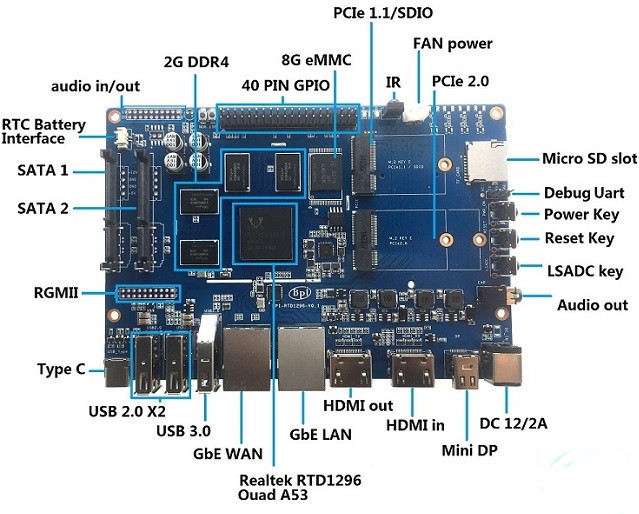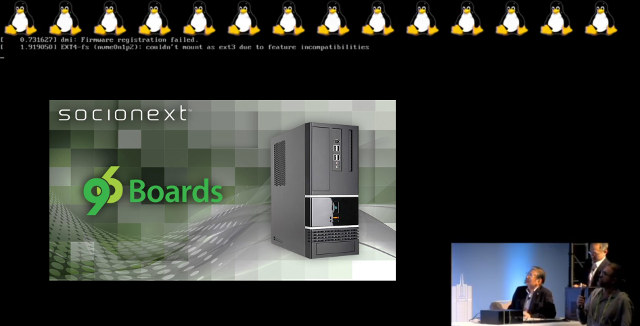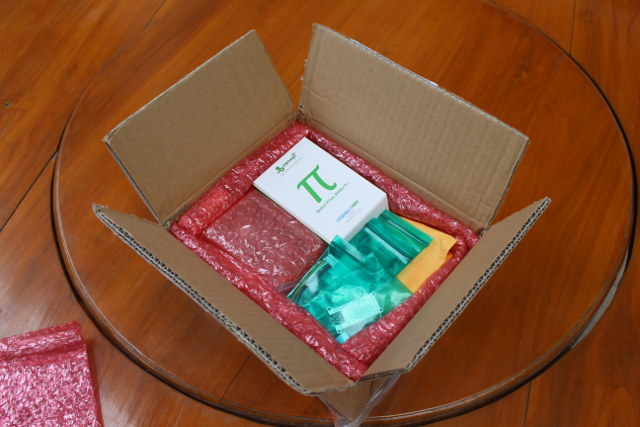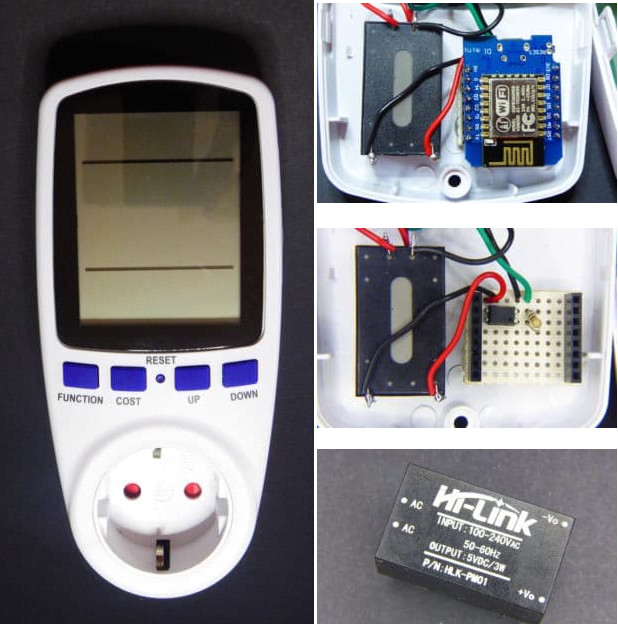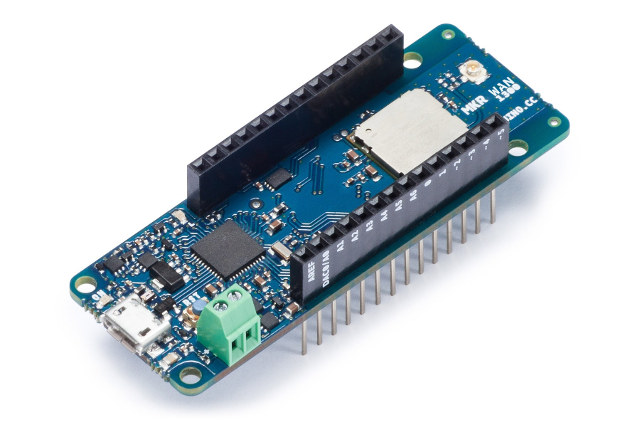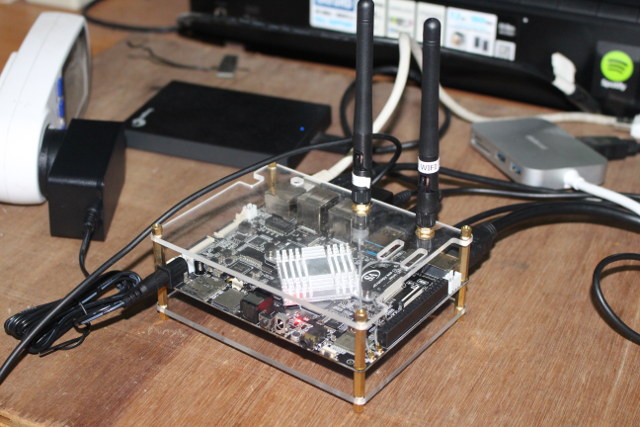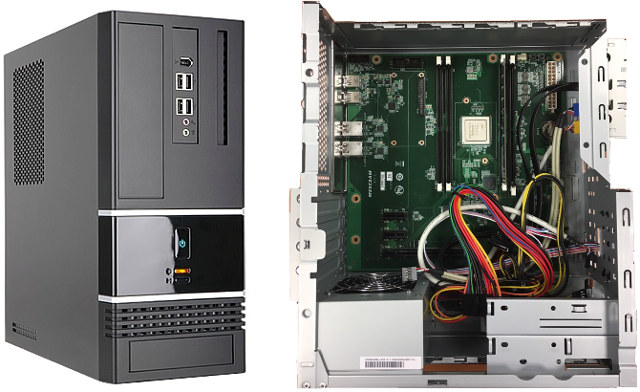I’ve reviewed several Realtek RTD1295 platforms with Zidoo X9S and Eweat R9 Plus, and I was generally impressed by the storage, Ethernet, and WiFi performance. 4K video playback was good too, as long you don’t have any 4K H.264 videos at 30 fps or more. Most devices would also run Android and OpenWrt side-by-side bringing the best of both operating for respectively apps & multimedia, and server functions. HDMI input – with PVR, time-shifting and PiP functions – was also a bonus, However so far, nobody cared to design a maker board powered by RTD1295 processor. Since then we’ve learned Realtek was working on RTD1296 processor with even more Gigabit Ethernet, USB 3.0, and SATA interfaces, and SinoVoIP has now designed a board based on the SoC called Banana Pi BPI-W2. Banana Pi BPI-W2 preliminary specifications: SoC – Realtek RTD1296 quad core Cortex A53 processor with ARM Mali-T820 MP3 GPU […]
Short Demo with 96Boards SynQuacer 64-bit ARM Developer Box
Even if you are working on ARM platforms, you are still likely using an Intel or AMD x86 build machine, since there’s not really a good alternative in the ARM world. Linaro talked about plans to change that at Linaro Connect Budapest 2017 in March, and a few days ago, GIGABYTE SynQuacer software development platform was unveiled with a Socionext SynQuacer SC2A11 24-core Cortex-A53 processor, and everything you’d expect from a PC tower with compartment for SATA drives, PCIe slots, memory slots, multiple USB 3.0 ports, and so on. The platform was just demonstrated a Linaro Connect San Francisco right after Linaro High Performance Computing keynotes by Kanta Vekaria, Technology Strategist, Linaro, and Yasuo Nishiguchi, Socionext’s Chairman & CEO. If you have never used a system with more than 14 cores, you’d sadly learn that the tux logos at boot times will only be shown on the first line, skipping […]
Linaro Connect SF 2017 Welcome Keynote – New Members, Achievements, the Future of Open Source, and More…
Linaro Connect San Francisco 2017 is now taking place until September 29, and it all started yesterday with the Welcome Keynote by George Grey, Linaro CEO discussing the various achievements since the last Linaro Connect in Budapest, and providing an insight to the future work to be done by the organization. The video is available on YouTube (embedded below), and since I watched it, I’ll provide a summary of what was discussed: Welcoming New Members – Kylin (China developed FreeBSD operating systems) joined LEG (Enterprise Group), NXP added LHG (Home Group) membership, and Xilinx joined LITE (IoT and Embedded). Achievements OPTEE open portable trusted environment execution more commonly integrated into products. Details at optee.org. LEG 17.08 ERP release based on Linux 4.12, Debian 8.9 with UEFI, ACPI, DPDK, Bigtop, Hadoop, etc… LITE group has been involved in Zephyr 1.9 release, notably contributing to LwM2M stack More projects to be found […]
NanoPi Duo Starter Kit Review – Part 1: Unboxing and Assembly
NanoPi Duo is an inexpensive Allwinner H2+ quad core board with 256MB or 512MB RAM that can fit into a breadboard, and FriendELEC also provides a starter kit with a carrier board, heatsink, enclosure, USB debug board and cable, as well as optional accessories such as an half-length SSD drive. The company sent me two kits for review, so I’ll first check out what I got, and show how to assemble the kit, before actually playing with the board and kit next month. NanoPi Duo Starter Kit Unboxing I got a bunch of boxes and bubble wraps in the package… … and indeed received two identical kits. Each kit comes with a NanoPi Duo board with soldered headers, a mini Shield for NanoPi Duo, a heatsink and thermal pad set, a micro USB to USB cable, a USB to TTL debug board and cable, and acrylic case, and user manuals […]
ESPurna Firmware Now Supports Power Meters “Augmented” with ESP8266 Modules/Boards
Sonoff-Tasmota and ESPurna are the two main open source firmware used in home automation devices, such as Sonoff wireless switches, based on Espressif ESP8266 WiSoC. Xose Pérez – aka Tinkerman – has recently purchased “dumb” power meters / kill-a-watt meters, added WiFi to them with ESP-01 module and Wemos D1 mini board, and implemented support in ESPurna firmware leveraging earlier reverse-engineering work by Karl Hagström. The power meter above looks exactly like the one I’ve been using for review for over two years, and has been more more reliable than other models, such as Broadlink SP2 (with built-in WiFi) that gave up on me after a few months. Xose actually noticed that old and newer models of the power meters were based on different solutions. Karl’s meter relied on ECH1560, while Xose’s new meter was instead based on Vango V9261F, which has a public datasheet, and was already being worked on by […]
Arduino MKR WAN 1300 & MKR GSM 1400 Boards Launched with LoRaWAN and 3G Connectivity
Arduino has introduced two new boards right in time for Maker Faire New York: MKR WAN 1300 with a LoRa radio, and MKR GSM 1400 with a “3.75G” cellular module, both software compatible with Arduino Zero, and in Arduino MKRZero board form factor. MKR WAN 1300 Board Arduino MKR WAN 1300 specifications: MCU – Microchip Atmel SAMD21 32-bit ARM Cortex M0+ MCU @ 48 MHz with 32 KB SRAM, 256 KB flash (8KB for bootloader) Digital I/O Pins – 8x digital I/Os, 12x PWM, UART, SPI, and I2C, 8x external interrupts Analog Pins – 7x analog inputs (8/10/12-bit ADC), and 1x analog output (10-bit DAC) DC Current per I/O Pin – 7 mA LPWAN connectivity Murata CMWZ1ZZABZ LoRa module based on Semtech SX1276 and STMicro STM32L Antenna power – 2dB Carrier frequency – 433/868/915 MHz Working regions – EU/US USB – 1x micro USB port for power and programming […]
Checking Out Debian and Linux SDK for VideoStrong VS-RD-RK3399 Board
VideoStrong VS-RD-RK3399 (aka VS-RK3399) is a features-packed development board powered by Rockchip RK3399 hexa core core processor which offers an alternative to Firefly-RK3399 board. The company sent me a development kit for evaluation, and I’ve already looked into VS-RD-RK3399 hardware and SDK in the first part of the review. Today, after shortly looking into the pre-installed Android 7.1 OS to make sure the board boots fine, I’ll report my experience with Debian 9, and building it from source. A Quick Look at Android 7.1 I connected the board to my HDMI TV, added an Ethernet cable, and after powering it, VS-RK3399 promptly booted into Android 7.1 with the following launched. It just has a few apps pre-installed, and lack Google Play store, but as I’ve seen in the new version of the SDK, a patch for Google Play store is provided, if that’s something you need for your use case. […]
GIGABYTE SynQuacer 96Boards Enterprise Platform is Powered by SocioNext SC2A11 24-core ARMv8 SoC
GIGABYTE, Socionext and Linaro have partnered to design a software development platform compliant with 96Boards Enterprise specifications, with GIGABYTE taking care of manufacturing the hardware based on Socionext SC2A11 processor, while Linaro will provide support via 96Boards community. GIGABYTE SynQuacer platform preliminary specifications (based on photos and SC2A11 specifications): SoC – Socionext SynQuacer SC2A11 24x ARM Cortex-A53 MPCore cores @ up to 1GHz, with 32KB/32KB I/D L1 cache, 256 KB L2 cache, and 4MB L3 cache (5W power consumption) System Memory – 4x DIMM slots for 64-bit DDR4-2133Mbps with ECC up to 64GB Storage – 32GB Samsung KLMBG2JENB-B041 eMMC 5.1 flash + 2x SATA interfaces Connectivity – 2x Gigabit Ethernet (RJ45) with IPSec Network Offload Engine USB – 2x USB 3.0 ports on motherboard (via Renesas D720201), 4x USB ports on front panel via expansion board Audio – 1x microphone input, 1x speaker output on front panel Expansion – 1x PCie […]


